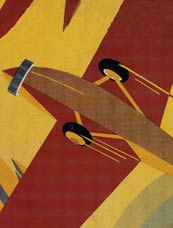|
HELL’S ANGEL
NC2576 was the first S-29-A made by Sikorsky (S/N 1). The "A" stands for "America". It was manufactured, according to the official record, during September, 1924 by the Sikorsky Manufacturing Corp. It was an eleven-place biplane weighing 11,016 pounds gross.
But, according to an unofficial account (Glines, page 65) it made its first flight on May 4, 1924, four months before the official record says it was made. Regardless, NC2756 left the factory with two Liberty engines of 400HP each. It was flown from Roosevelt Field first by Igor Sikorsky, but at some point it had had two Hisso engines installed and it was underpowered. Sikorsky struggled to get it airborne and crash landed at nearby Mitchel Field.
From the official record, its history between 1924 and 1927 is unclear. The complete record for NC2576 aquired from the FAA says it was remodeled by the manufacturer during December, 1926 and sold to Roscoe Turner of Richmond, VA on May 19, 1927.
However, Glines' book has Turner flying it earlier. The discrepancy between the dates of his use and the date of his acquisition probably has to do with a time-payment deal Turner worked out between himself, Sikorsky and a local businessman/friend Shelby H. Curlee of Corinth, MI. Curlee agreed to fund Turner's purchase, and Sikorsky, circa late 1925, accepted $1,000 down on a $10,000 total agreed purchase price. It took Turner until May, 1927 to pay the full price and gain title to the airplane.
BI-PLANE HAS ON BOARD TWO BABY GRANDS
Leaves Roosevelt Field Today; One Consigned to
Mrs. Coolidge.
Mineola, N. Y.. April 23.—A plane loaded with two baby grand pianos and carrying six men left Roosevelt Field today for Washington. One of the pianos was consigned to Mrs. Calvin Coolidge and was to be delivered to her secretary at Boiling Field, where the plane was scheduled to land at noon. The second instrument was for a Washington
piano dealer.
Colonel Harold E. Hartney, president of the General Airway, Inc.. who was aboard the plane, said that the company plans to operate an aerial freight line between Boston and St. Paul. Minn.
|
One clue to its life in 1925 is in the next four photographs from the Library of Congress identified for us by Tim Kalina (cited, right sidebar). Follow the link to download your own TIF file, which can then be magnified to see the interesting details of these high-resolution images.
The first two photos show the airplane off-loading PIANOS(!) at Bolling Field, Washington, DC. Below, one of the pianos is being lowered carefully from the narrow door of the airplane. With the packing and cushioning around it, the instrument was undoubtedly a tight fit through the door. These are glass plate negatives and I have left the borders around them for your enjoyment. The reason the pianos were delivered as freight is stated in the unsourced news article at right. One of the pianos was for Mrs. Coolidge, and will go to a community center in which Mrs. Coolidge was interested.
Off-Loading a Piano, April 23, 1925 (Source: Library of Congress via Kalina)
 |
The gentleman standing at right holds a newspaper titled "Music Trades." He can be seen at far left in the photo below holding the same paper. In the next photo the piano is set up and a gentleman is playing it. Can anyone IDENTIFY the pianist? He is the only one in the photo who wears spats. His piano stool is a classic claw foot design clutching glass spheres.
Off-Loading a Piano, April 23, 1925 (Source: Library of Congress via Kalina)
 |
NEW AIRPLANE TAKES PIANO TO MRS. COOLIDGE
Giant Sikorsky Biplane with Two Pianos and Six Men Aboard on Trial Flight,
Washington, April 23.—-With two baby grand pianos aboard and six men, the giant Sikorsky biplane which left the Roosevelt flying field on Long Island, today, arrived at Bolling field here at 11:55 a. m., making the trip in three hours. The plane was piloted by Igor Sikorsky, the inventor.
|
Igor Sikorsky stands with hat in hand fifth from the left. We can see that more than one piano was shipped because of the additional set of legs in the foreground. The unsourced news article at left verifys that two pianos were on board, as well as six men.
The next views were taken two weeks later. They are of the front of the airplane with a crowd of unidentified people. The photo caption reads, "Christening of Sikorsky plane, 5/8/25." Under magnification, the two gentlemen on the far left wear knickers and socks; the man in the fedora third from left looks like Igor Sikorsky, who flew the airplane (see below); the officer fifth from left wears spurs on his boots. The mechanic on the starboard wing holds a can labeled "Mobiloil." Sikorsky holds what appears to be a movie camera. (Glass plate edges cropped off). This photograph appears at the link in support of an article about air transport that appeared in The New Yorker magazine. The article, wlhich was publishedin the magazine's "Talk of the Town" section, was dated September 4, 1926. Thanks to a site visitor for calling the article to my attention.
Sikorsky S-29, NC2756, May 8, 1925 (Source: Library of Congress via Kalina)
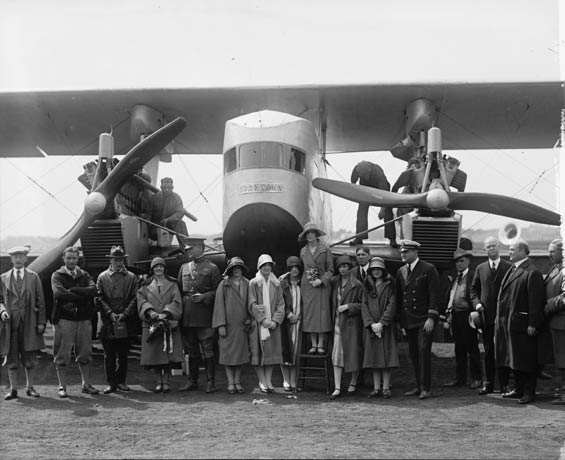 |
The description of the second photo, below, reads, "Miss Elizabeth Owens christens Sikorsky plane, [5/8/25]." Ms. Owens appears standing on the chair in the photo above. The prow of the airplane wears an embossed sign reading, "YORKTOWN." The Mobiloil can is visible at left foreground in this photograph. Magnification shows shadows playing on Ms. Owens' face from the sun shining through the mesh of her hat. The woman at far right wears a fur collar that appears to be fashioned from a full mink.
Sikorsky S-29, NC2756, May 8, 1925 (Source: Library of Congress via Kalina)
 |
The Washington Post of May 9, 1925 headlines, "Yorktown Airplane Service Instituted" and provides context for the two photographs. The article states, "Six days were required by messengers on horseback to carry news of Cornwallis' defeat from Yorktown, Va., to New York in 1781. Yesterday the same distance was covered in a few hours by the giant Sikorsky transport which instituted airplane passenger service between New York and Yorktown, and was christened with brief ceremonies at Bolling field.
"The plane left New York at 10 o'clock. At Logan Field, Baltimore, it was forced to earth on account of a water leak, which was quickly remedied by workmen. The plane loomed into sight above Bolling field at 1:45 o'clock, ten minutes before it was expected. Army officers and guests welcomed the passengers. An address was delivered by Gen. R. Allyn Lewis. Count Igor Sikorsky, designer and builder of the plane, who piloted the craft to Washington, also spoke.
"A bottle of water [don't forget, Prohibition was in effect] was broken across the bow of the plane by Miss Elizabeth Owens, who christened the plane the 'Yorktown.' "Following the christening, the plane flew to Yorktown, where zero milestones commemorative of the event are to be placed. The service has been established for New York business men who spend week-ends in Virginia."
Another photograph of the ceremony is supplied below shared with us by site visitor Richard Hubbard. The photographer was just to the right of the one who took the photo above.
Sikorsky S-29, NC2756, May 8, 1925 (Source: Hubbard)
 |
The name of the airplane is clearly seen on the placard, and the clamped water hoses, which may have been the source of the leak and forced landing, are clearly visible at the top front of the engine. Mr. Hubbard says about the photograph, "The photo was in an envelope with 20 or so old family photos all from 1925. My grandfather lived in Virgina in those days although I have no idea who may have been operating the camera."
Below, the caption on the back of the photograph. We learn Ms. Owens was Miss Washington at the time. The formal typewritten label suggests this was an official military photograph, taken by F.E. Colbert, acquired by Mr. Hubbard's grandfather.
Sikorsky S-29, NC2756, May 8, 1925, Caption (Source: Hubbard)
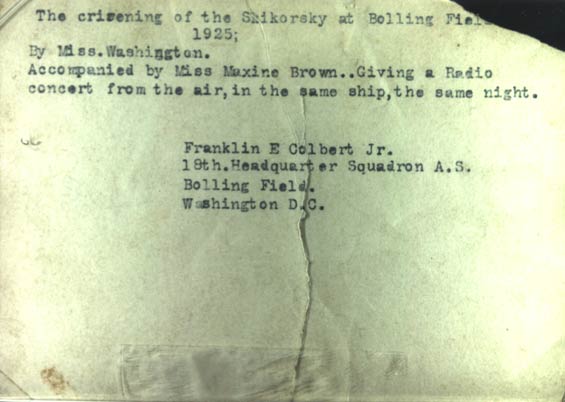 |
Now come additional images below shared with us by Tim Kalina. These images are circa 1925-1927 when Turner used (but did not own) the airplane under the sponsorship of S.H. Curlee. Curlee owned a clothing company in St. Louis, MO for which Turner agreed to make promotional flights. In the next eleven images we see NC2576 in Curlee Clothing livery.
NC2756, Roscoe Turner (L), C.Z. Pedrick (R)
(Source: Kalina)
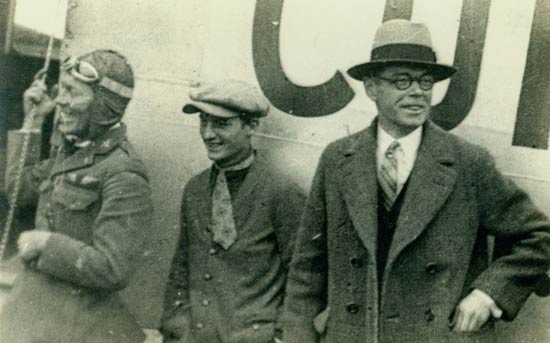 |
Above, a young (and slim) Roscoe Turner on the left. The image caption on the back identifies the gentleman on the right as C.Z. Pedrick, who may be an official with the Curlee Clothing Company. The location on this and all the other images from Tim Kalina is given as St. Louis.
NC2756
(Source: Kalina)
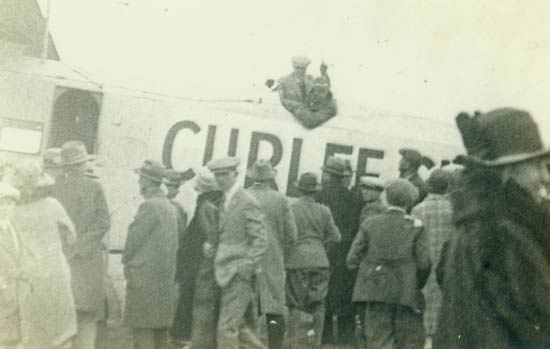 |
Above, Roscoe Turner in the cockpit. The S-29-A was a large airplane. The fuselage was 50 feet long and the wingspan was 69 feet. It was flown from the open cockpit behind the wing.
NC2756
(Source: Kalina)
 |
Above, another profile showing Turner aboard and the large fuselage passenger compartment. The airplane was rated for 14 passengers sitting in wicker chairs. This appears to be a demonstration of the airplane to the St. Louis populace. The weather was cool and breezy, considering the clothing.
NC2756
(Source: Kalina)
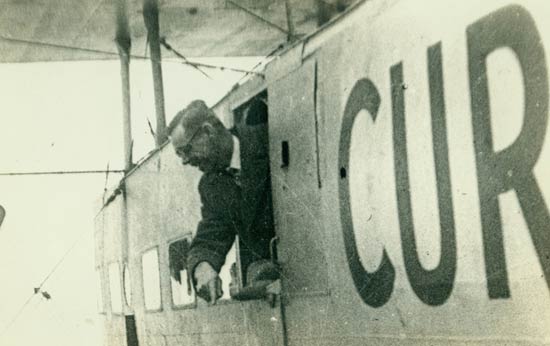 |
Above, C.Z. Pedrick giving instructions. The two Liberty engines moved this airplane at 116MPH. It could operate, and climb, on one engine. Cruise speed on one engine was 75MPH.
NC2756
(Source: Kalina)
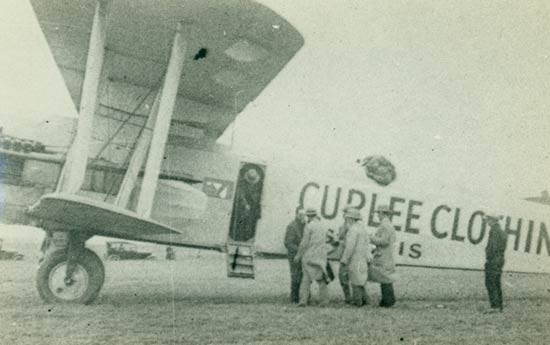 |
Above, NC2756 gets an inspection by well-dressed men. The airplane's altitude ceiling was 12,500 feet.
NC2756
(Source: Kalina)
 |
Above, this wide view gives a good sense of how really large this airplane was. The design was called a sesquiplane, as the lower wings were shorter than the upper. Note the lack of dihedral and the boat-shaped fuselage.
NC2756
(Source: Kalina)
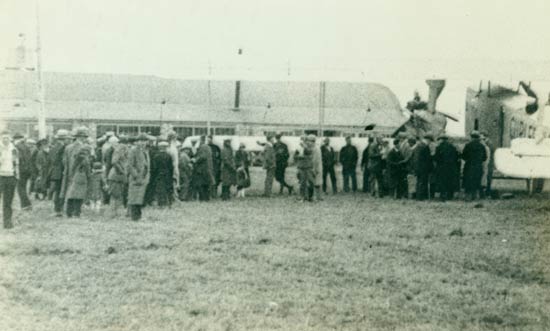 |
Above, the St. Louis throng was typical of the interest shown such a large airplane. Turner exploited the attention to sell his own agenda regarding his air transport and charter interests, as well as the future of airports and airlines in the United States. He was an extraordinary marketer.
NC2756
(Source: Kalina)
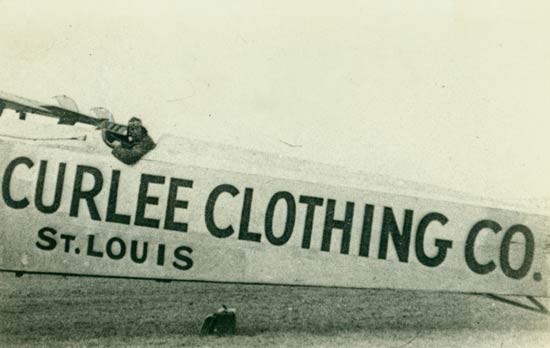 |
Above, Turner in the cockpit of NC2756. By today's standards, this must have been an extremely uncomfortable ride for the pilot. The livery is shown well.
NC2756
(Source: Kalina)
 |
Above, an exciting late 1920s portrait of aircraft technology and well-tailored fashions for men and women. Turner is in the cockpit; C.Z. Pedrick is under the blue arrow.
NC2756 Sponsor
(Source: Kalina)
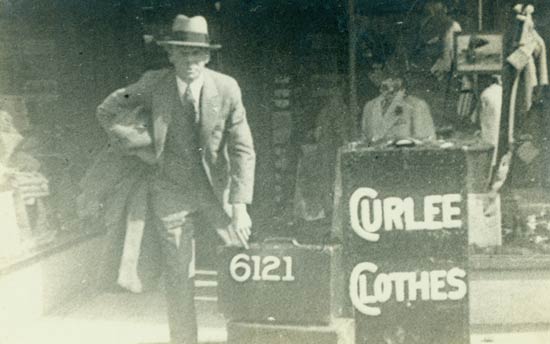 |
Above, an image connected to our airplane only by the name "Curlee Clothes". Although conjecture, the significance of the connection is ventured by a site visitor, October 14, 2009. He states, "I don't know if there is a direct connection, but Shelby Curlee Jr. was a graduate of Yale in '26 along with my father and H. M. Horner. H. M. Horner took a job, after Yale, as secretary of Pratt and Whitney, a division of United Aircraft, of which Sikorsky became a division in July 1929. Possibly in a search for an aircraft to fly salesmen to their territories as a promotional venture, Curlee contacted Horner who contacted Turner.
Further he reveals the significance of "6121". He states, "The number 6121 refers to the model number 6121, which was a blue serge fabric suit made by Curlee Clothing Co. and was its best seller. The company's phone number was 231-6121 because of the popularity of the suit."
He states finally, "My father was president of Curlee Clothing Company from the mid '60s until '71. There are so many stories. ... both Curlee and Turner were from Corinth, Mississippi and I would believe that connection was relevant in using Turner for the promotional flights. As for the people in the picture, I would assume they are with the sales department as well as members of the Curlee family, but I do not recognize anyone. The location of the photograph could be Lambert Field in St. Louis. ... Curlee had factories in St. Louis, Winchester, KY and Mayfield, KY. ... Curlee was a good company that was profitable even during the depression. The importation of good low cost clothing ended most U.S. clothing manufacturing. The Mayfield plant closed around 1980 and the former employees now have annual reunions that began in 2004. There is a strong feeling among the former Mayfield Curlee employees of 'family'. My father was plant manager from 1929 until 1963 and, according to the U.S. Government Head Start program, started the first employer day care center for employee's children in the country. An era has passed, but others begin."
NC2756
(Source: Kalina)
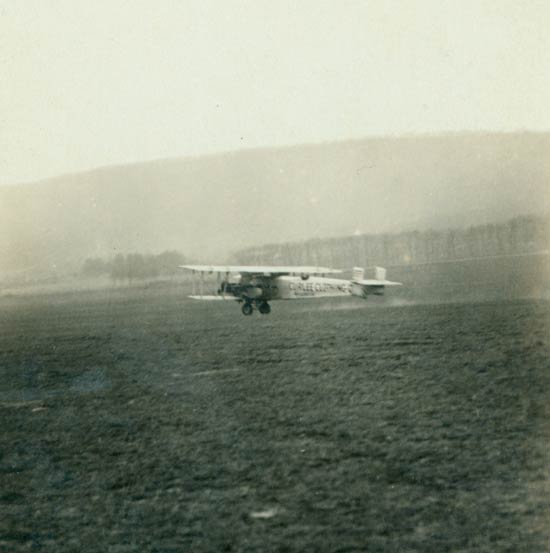 |
Above, a nice image of the airplane either departing or landing. The field appears to have a downhill advantage, so this may be a takeoff.
NC2756
(Source: Kalina)
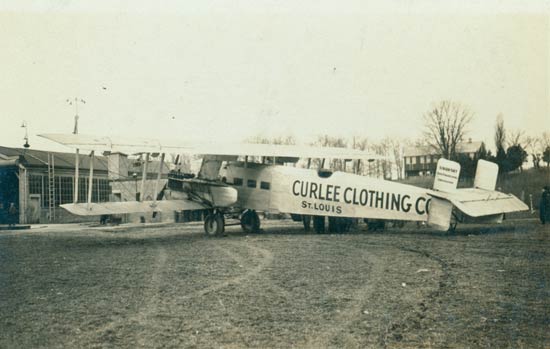 |
Above, our final image of this great airplane.
1927 Harley-Davidson Motorcycle (Source: Web via Barnes)
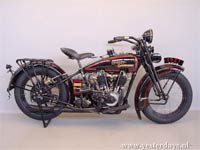 |
At the time NC2756 was "officially" purchased by Turner in 1927, it had accumulated about 300 total flight hours. According to the official record, it was delivered to Turner at Curtiss Field, LI, NY. Through another advertising deal negotiated by Turner, the airplane was then used as the “Flying Cigar Store” under contract with United Cigar Stores. Below, is a photograph of the airplane in United Cigar livery. It is dated July 5, 1927.
When I uploaded this page I asked if anyone knew about the motorcycle at right in the photo. Site visitor Bill Barnes states that it is a 1927 Harley-Davidson. He states, "Notice the teardrop aft portion of the gasoline tank in your picture ... and how the frame maintains the teardrop line. ... Notice the flattened tailpipe of this model with the rack frame. The motorcycle in your picture has a flattened tailpipe too with a large drum brake." The model he refers to is at right from the link.
Sikorski S-29, NC2756, July 5, 1927 (Source: Kalina)
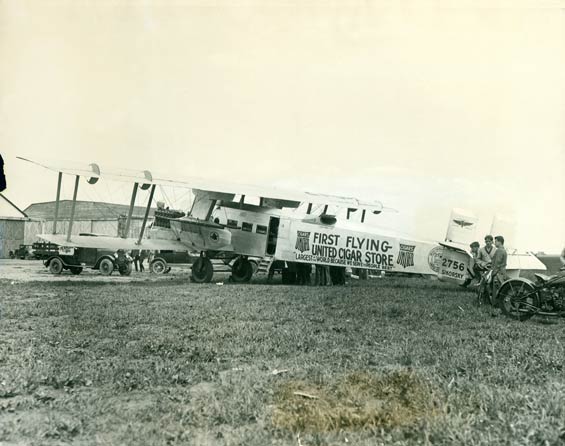 |
NC2756 landed at the Davis-Monthan Airfield on Thursday, February 23, 1928 at 6:30 AM. It was flown by Roscoe Turner, who carried with him two mechanics identified as Eagan & Erwin, and Turner's wife. They were westbound from Lordsburg, NM to Nogales, AZ. Below, the registration certificate for the airplane issued to Turner June 1, 1928.
NC2756 Registration Certificate, June 1, 1928
(Source: NASM)
 |
According to the official bill of sale, as of April 3,1928 Turner transferred NC2756 to the Caddo Company, Inc., Hollywood, CA, Howard Hughes, President. Curiously, this date of sale precedes the registration certificate, above, by a couple of months. It must have taken time for the system to catch up. Regardless, NC2756 was used by Hughes for motion picture photography in the Los Angeles, CA area. In a letter to the Director of Aeronautics, Turner states that Caddo Productions, " ... converted it from a passenger plane into a bomber...." Below, courtesy of the San Diego Aerospace Museum Flickr Stream (SDAM), is a photograph of NC2756 in bomber livery.
Sikorsky NC2756 in Gotha Bomber Livery, Ca. 1929 (Source: SDAM)
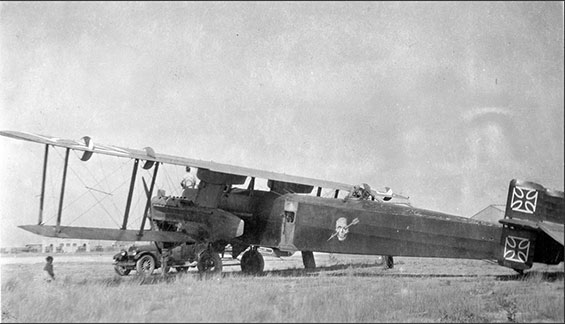 |
And therein lies the airplane’s fate. It suffered an accident on March 22, 1929 at Pacoima, CA. Pilot Al Wilson left by parachute and was slightly injured. One passenger, Phil Jones, was killed. The cause of the accident was listed as, “Acrobatic maneuvers being done for movie picture ‘Hell’s Angels’”. The story of early motion picture flying, including additional photographs of NC2756 on the ground in "Hell's Angels" Gotha bomber livery, with two people hanging off the left propeller, can be found in Wynne, page 63. The airplane was completely destroyed and the license was cancelled April 19, 1929. Aerofiles.com exhibits the following entry for 2756.
| S-29-A 1924 = 16pO/CB; two 400hp Liberty 12; span: 69'0" length: 49'10" load: 4225# v: 115/100/56 ceiling: 12,300'; ff: 5/4/24. Igor Sikorsky. First Sikorsky built in the US, originally had 220hp Hispano-Suizas, but was repowered with Liberty 12s in rebuild after damage in a forced landing [2756]. The suffix "-A" denoted "Made in America," as 28 previous S-numbers were all built and utilized in Russia. An historic machine, it was owned by Roscoe Turner and made many long-distance flights in the East and Midwest 1925-27, was even used to deliver two grand pianos. Sold to Howard Hughes' film company in 1928 and appeared as the German Gotha-type bomber in "Hell's Angels" 1930, where it was destroyed in the filmed crash. |
---o0o---
The big Sikorsky flies again as a featured airplane in the April 24, 2008 Christie's auction catalog of important watches. Lot number 143 in the catalog (pp. 108-110, with fold-out) is a Patek Philippe chronograph wrist watch. The owner of this watch was the grandson of Shelby Curlee, who founded the clothing company and owned NC2756. Below are images from the Christie's catalog, used with permission.
Lot 143, Patek Philippe Chronograph Wrist Watch, p. 108
(Source: Christie's)
 |
The "Property of a Gentleman"...
Lot 143, Patek Philippe Chronograph Wrist Watch, p. 109
(Source: Christie's)
 |
Below, both sides of the fold-out page. The back of the watch is engraved "Shelby H. Curlee III".
Certificate of Provenance
(Source: Christie's)
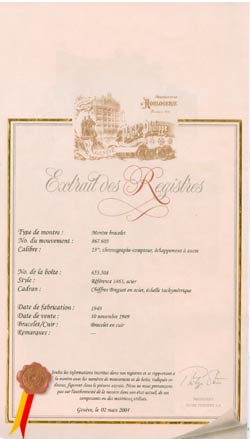 |
Three Detail Images
(Source: Christie's)
 |
Many thanks to Christie's for allowing us to exhibit these fine images from their catalog, and for their generous donation to Delta Mike Airfield, Inc.
---o0o---
Dossier 3.1.51.1
THIS PAGE UPLOADED: 12/28/07 REVISED: 02/27/08, 03/29/08, 10/14/09, 10/12/11, 12/23/11, 03/14/12, 12/19/14
|

